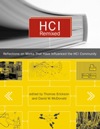Book: HCI Remixed
Edited by Thomas Erickson and David W. McDonald
MIT Press, 2008
Hardcover, 344 pages
> Table of Contents
Abstract
Over almost three decades, the field of human-computer interaction (HCI) has produced a rich and varied literature. Although the focus of attention today is naturally on new work, older contributions that played a role in shaping the trajectory and character of the field have much to tell us. The contributors to HCI Remixed were asked to reflect on a single work at least ten years old that influenced their approach to HCI. The result is this collection of fifty-one short, engaging, and idiosyncratic essays, reflections on a range of works in a variety of forms that chart the emergence of a new field.
An article, a demo, a book: any of these can solve a problem, demonstrate the usefulness of a new method, or prompt a shift in perspective. HCI Remixed offers us glimpses of how this comes about. The contributors consider such HCI classics as Sutherland’s Sketchpad, Englebart’s demo of NLS, and Fitts on Fitts’ Law–and such forgotten gems as Pulfer’s NRC Music Machine, and Galloway and Rabinowitz’s Hole in Space. Others reflect on works somewhere in between classic and forgotten–Kidd’s “The Marks Are on the Knowledge Worker,” King Beach’s “Becoming a Bartender,” and others. Some contributors turn to works in neighboring disciplines–Henry Dreyfuss’s book on industrial design, for example–and some range farther afield, to Lovelock’s Gaia hypothesis and Jane Jacobs’s The Death and Life of Great American Cities. Taken together, the essays offer an accessible, lively, and engaging introduction to HCI research that reflects the diversity of the field’s beginnings.
Or in the words of John Thackara:
BED-TIME STORIES FOR GEEKS
Tom Erickson has published a collection of 51 short, personal essays and reflections on the story-so-far of human computer interaction. Each text reflects on a piece of work – book, paper, demo – that’s at least 10 years old. Tom tells me he thinks of it as “bedtime stories for HCI geeks”.




